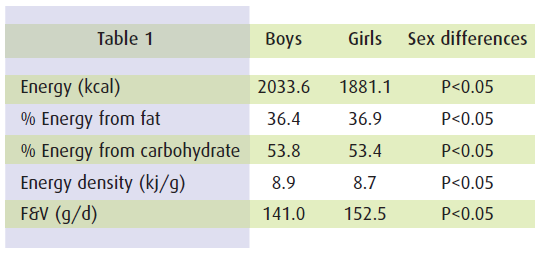Obesogenic diet and physical activity: independent or associated behaviours in adolescents?
Obesity is the result of a gap between energy intake and Energy expenditure1. Eating energy-dense food has been associated with an increase in BMI2-3 whereas Fruit and Vegetables (F&V)4 consumption has been associated with a decrease in BMI. Moreover, physical activity has been associated with positive dietary behaviours5. The objective of the present study is to evaluate the association between physical activity and obesogenic dietary behaviours in British adolescents.
Adolescents from the ALSPAC study
The Avon Longitudinal Study of Parents and Children (ALSPAC)6 is a birth cohort study involving more than 14,000 pregnant women and following the newborns. Adolescents (n=5134) included in the present analysis were offspring of these women. Adolescents answered to a one day diet questionnaire at age 10. Estimation of daily energy consumption and sources of Energy (fat or carbohydrate) were estimated from this questionnaire, as well as F&V intake (excluding juice, potatoes and baked beans). At age 11, adolescents would wear an accelerometer for one week, which allowed assessing their physical activity (CPM: Count Per Minute; MVPA: Moderate-to-Vigourous Physical Activity).
Diet and physical activity: associated behaviors
There was a sex difference in dietary intakes (Table 1). Energy consumption was higher in boys, as well as energy density. Girls consumed a greater percentage of their energy from fat than boys, while boys consumed a greater percentage of their Energy from carbohydrate. Moreover, girls consumed on average more F&V than boys (152g/d vs. 141g/d).

In boys, energy from fat was only negatively associated with physical activity (β=[-0.055;-0.101] (depending on the adjustments), p<0.05). Total energy (β=[0.066;0.91], p<0.05) and energy from carbohydrate (β=[0.054;0.106], p<0.05) was positively associated with physical activity. In girls, F&V consumption was positively associated with physical activity (β=[0.056;0.074], p<0.005).
Conclusions
In this study, physical activity was only very weakly associated with dietary intakes. Interventions to change behaviours in adolescents should focus on diet as well as physical activity. Nevertheless, implementing strategies should assess the most effective means of changing diet and physical activity separately or in the same time.
References
- Jackicic JM (2002) J Nutr 132, Suppl., 3826S-3829S.
- Johnson L et al. (2008) Am J Clin Nutr 87, 846-854.
- Johnson L et al. (2008) Int J Obes (Lond) 32, 586-593.
- Tohill BC et al. (2004) Nutr Rev 62, 365-374.
- Jago R et al. (2004) Obes Res 12, Suppl., 55S-63S.
- Golding J et al. (2001) Paediatr Perinat Epidemiol 15, 74-87.
